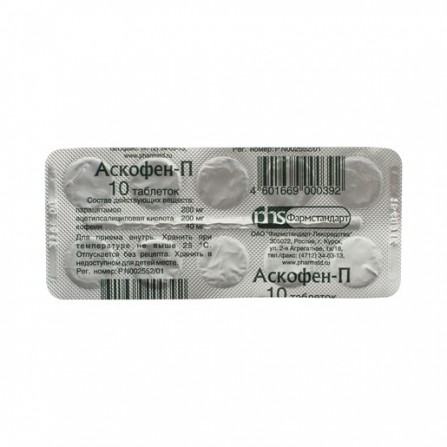Ascofen P Pharmstandard Tablet N10
Condition: New product
997 Items
Rating:
Be the first to write a review!

More info
Active ingredients
Acetylsalicylic acid + Caffeine + Paracetamol
Release form
Pills
Composition
1 tab. Acetylsalicylic acid 200 mg paracetamol 200 mg Caffeine 40 mg Supplementary substances: potato starch, povidone (low-molecular medical polyvinylpyrrolidone), stearic acid, talcum, calcium stearate, KE-10-12 silicone emulsion, vaseline oil QMM
Pharmacological effect
Combined analgesic drug, the effect of which is determined by the components in its composition. Acetylsalicylic acid has an analgesic, antipyretic, anti-inflammatory effect associated with the suppression of COX-1 and COX-2, which regulate the synthesis of prostaglandins; inhibits platelet aggregation. Paracetamol has antipyretic, analgesic effect. Caffeine increases the reflex excitability of the spinal cord, stimulates the respiratory and vasomotor centers, dilates the blood vessels of skeletal muscles, brain, heart, kidneys, reduces platelet aggregation; reduces sleepiness, fatigue, increases mental and physical performance.
Pharmacokinetics
Data on the pharmacokinetics of the drug Askofen-P is not provided.
Indications
Moderate or mild pain syndrome in adults: - headache; - migraine; - toothache; - neuralgia; - thoracic radicular syndrome, lumbago; - arthralgia; - myalgia; - algomenorrhea.For reducing fever in adults and children over 15 years: - with acute respiratory infections; - with infectious and inflammatory diseases.
Contraindications
- Hypersensitivity to the components of the drug; - Hypersensitivity to other NSAIDs, xanthines; - Erosive and ulcerative lesions of the gastrointestinal tract in the acute phase; - Gastrointestinal bleeding; - Severe renal dysfunction; - Severe hepatic dysfunction; - Asthma induced by acetylsalicylic acids, salicylates and other NSAIDs; - hemorrhagic diathesis (von Willebrand disease, hemophilia, telangiectasia, hypoprothrombinemia, thrombocytopenia, thrombocytopenic purpura); - aor aneurysm you; - deficiency of glucose-6-phosphate dehydrogenase; - portal hypertension; - vitamin K deficiency; - increased excitability, sleep disturbance, anxiety disorders (agoraphobia,panic disorders); - organic diseases of the cardiovascular system (acute myocardial infarction, severe ischemic heart disease, arterial hypertension), paroxysmal tachycardia, frequent ventricular extrasystole; - glaucoma; - surgical interventions accompanied by bleeding; - children under 15 years old caution: hyperuricemia, urate nephrolithiasis, gout, gastric ulcer and / or duodenal ulcer history, severe heart failure.
Precautionary measures
Application for violations of liver function. Contraindications: pronounced dysfunction of the liver. Application for disorders of renal function. Contraindications: pronounced dysfunction of the kidneys.
Use during pregnancy and lactation
Application of I and III trimesters of pregnancy is contraindicated, in the II trimester of pregnancy a single dose of the drug in recommended doses is possible only if the expected benefit to the mother outweighs the potential risk to the fetus. development - splitting of the upper palate; in trimester III - contributes to the inhibition of labor (inhibition of prostaglandin synthesis), closure of the arterial duct in the fetus, which causes pulmonary vascular hyperplasia and hypertension in the pulmonary circulation. If you need to use the drug during lactation, breastfeeding should be stopped. Acetylsalicylic acid is excreted in breast milk, which increases the risk of bleeding in a child due to dysfunction of platelets.
Dosage and administration
The drug is taken orally after meals 1-2 pills 2-3 times / day. The maximum daily dose is 6 pills. The break between taking the drug should be at least 4 hours. To reduce the irritating effect on the gastrointestinal tract, the drug should be taken after meals with water, milk, alkaline mineral water. If the kidney or liver function is interrupted, the interval between doses should be at least 6 hours. The drug should not be taken for more than 5 days if prescribed as an anesthetic. and more than 3 days as an antipyretic. Other doses and regimens are determined by the doctor.
Side effects
On the part of the digestive system: anorexia, nausea, vomiting, gastralgia, diarrhea, erosive and ulcerative lesions of the gastrointestinal tract, gastrointestinal bleeding, hepatic and / or renal failure. From the side of cardiovascular system: increased blood pressure, tachycardia. Allergic reactions: skin rash , Quincke's edema, bronchospasm. For prolonged use: dizziness, headache, visual disturbances, tinnitus, decreased platelet aggregation, hypocoagulation, hemorrhagic syndrome (including nasal bleeding, bleeding gums, purpura), lesions with renal papillary necrosis; deafness; Stevens-Johnson syndrome, toxic epidermal necrolysis (Lyell's syndrome), Reye's syndrome in children (metabolic acidosis, disorders of the nervous system and psyche, vomiting, abnormal liver function).
Overdose
Symptoms: nausea, vomiting, stomach pain, sweating, pale skin, tachycardia. For mild intoxication, ringing in the ears; severe intoxication - drowsiness, collapse, convulsions, bronchospasm, difficulty breathing, anuria, bleeding. As intoxication increases, progressive paralysis of respiration and dissociation of oxidative phosphorylation causes respiratory acidosis. Treatment: gastric lavage, taking adsorbents (activated carbon). If you suspect poisoning, you should immediately seek medical help.
Interaction with other drugs
The drug enhances the effect of Heparinia, indirect anticoagulants, Rezerpine, Steroids and Hypoglycemica. combinations of the drug with barbiturates, antiepileptic drugs, zidovudine, rifampicin, with drinks containing alk a goal (increases the risk of a hepatotoxic effect). Under the influence of paracetamol, the time of chloramphenicol excretion increases by 5 times caffeine. Caffeine accelerates ergotamine absorption. Salicylamide and other microsomal oxidation stimulants contribute to the formation of toxic metabolites of paracetamol, affecting the function of the liver; may enhance the effect of anticoagulants (dicoumarine derivatives).
special instructions
With prolonged use of the drug, control of peripheral blood and the functional state of the liver is necessary. Since acetylsalicylic acid has an antiplatelet effect, the patient, if he is to undergo surgery, must notify the doctor in advance about the drug being taken. Acetylsalicylic acid in low doses reduces uric acid excretion. In some cases, it can provoke a gout attack. During treatment, the patient should stop drinking alcoholic beverages (an increased risk of gastrointestinal bleeding). Use in pediatrics The drug is not prescribed as an anesthetic for children and adolescents under the age of 18 years, as antipyretic - children up to 15 years with acute respiratory viral infections due to the risk of Reye's syndrome (encephalopathy and acute fatty liver with acute development of liver failure).



